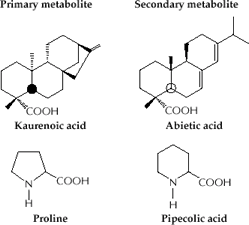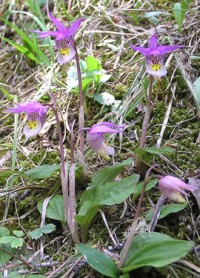- Primary metabolism contributing directly to growth and development, including photosynthesis, respiration, and protein synthesis. Compounds, such as phytosterols, acyl lipids, nucleotides, amino acids, and organic acids, are found in all plants and perform metabolic roles that are essential and usually evident.
- Secondary metabolism, producing substances that have no known direct function in basic metabolism, and are often differentially distributed among limited taxonomic groups within the plant kingdom.
- Phenolics: flavonoids, tannins, lignin, salicylic acid
- Terpenoids: aromatic oils, resins, waxes, steroids, rubber, carotenoids
- Alkaloids: often toxic, e.g., strychnine, nicotine, caffeine, cocaine, capsaicin
 Many secondary compounds have important adaptive significance in protection against herbivory and microbial infection, as attractants (pigments or scents) for pollinators and seed-dispersing animals, and as allelopathic agents (allelochemicals that influence competition among plant species). These secondary compounds seem to be important primarily in ecological interactions with other species.
Many secondary compounds have important adaptive significance in protection against herbivory and microbial infection, as attractants (pigments or scents) for pollinators and seed-dispersing animals, and as allelopathic agents (allelochemicals that influence competition among plant species). These secondary compounds seem to be important primarily in ecological interactions with other species.It is impossible to distinguish between primary and secondary metabolites by either structure or biochemistry. Therefore, it seems more appropriate to use a functional definition, with primary products participating in nutrition and essential metabolic processes inside the plant, and natural (secondary) products influencing ecological interactions between the plant and its environment.
 The various ways that animals move - running, swimming, flying - and obtain food - biting, chewing, sucking - are evidence of their adaptations to past environmental challenges. The particular form of an animal's adaptation is a specialization that has made it successful in its ecological niche. Secondary compounds are adaptations of plants to their environmental challenges. The same process of natural selection applies to all organisms: more ecologically successful individuals in the population leave more offspring that inherit the genetic basis of their parents' success. In each case the basic change occurs in the DNA, but the organism exhibits an adaptation that is the product of its history and environment. The result that we see today is what has worked in the past. Those that did not work went extinct.
The various ways that animals move - running, swimming, flying - and obtain food - biting, chewing, sucking - are evidence of their adaptations to past environmental challenges. The particular form of an animal's adaptation is a specialization that has made it successful in its ecological niche. Secondary compounds are adaptations of plants to their environmental challenges. The same process of natural selection applies to all organisms: more ecologically successful individuals in the population leave more offspring that inherit the genetic basis of their parents' success. In each case the basic change occurs in the DNA, but the organism exhibits an adaptation that is the product of its history and environment. The result that we see today is what has worked in the past. Those that did not work went extinct.Chapter 24 Natural Products (Secondary Metabolites)